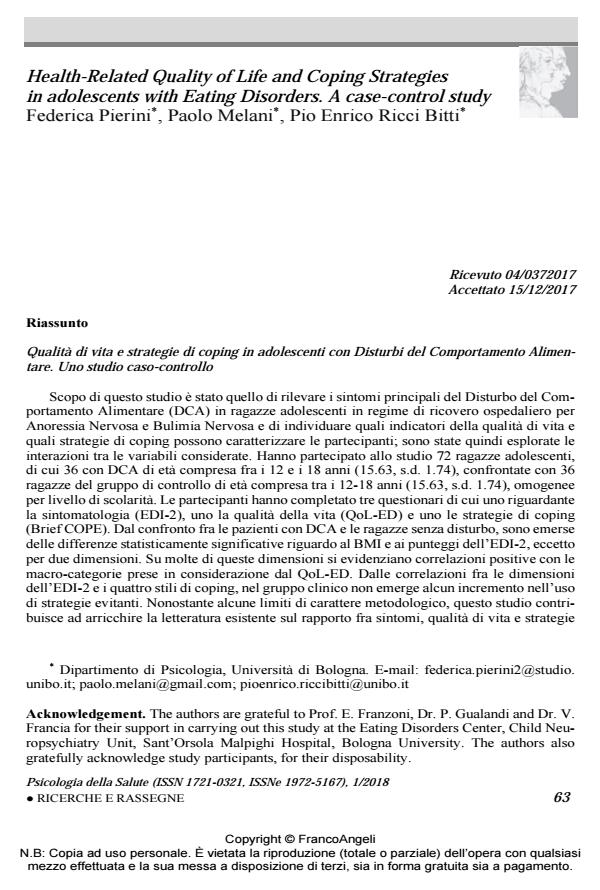Health-Related Quality of Life and Coping Strategies in adolescents with Eating Disorders. A case-control study
Titolo Rivista PSICOLOGIA DELLA SALUTE
Autori/Curatori Federica Pierini, Paolo Melani, Pio Enrico Ricci Bitti
Anno di pubblicazione 2018 Fascicolo 2018/1
Lingua Inglese Numero pagine 18 P. 63-80 Dimensione file 246 KB
DOI 10.3280/PDS2018-001004
Il DOI è il codice a barre della proprietà intellettuale: per saperne di più
clicca qui
Qui sotto puoi vedere in anteprima la prima pagina di questo articolo.
Se questo articolo ti interessa, lo puoi acquistare (e scaricare in formato pdf) seguendo le facili indicazioni per acquistare il download credit. Acquista Download Credits per scaricare questo Articolo in formato PDF

FrancoAngeli è membro della Publishers International Linking Association, Inc (PILA)associazione indipendente e non profit per facilitare (attraverso i servizi tecnologici implementati da CrossRef.org) l’accesso degli studiosi ai contenuti digitali nelle pubblicazioni professionali e scientifiche
The aim of this study was to examine Eating Disorders (ED) symptoms in adolescent girls hospitalized for Anorexia Nervosa (AN) and Bulimia Nervosa (BN) and to determine which Health-Related Quality of Life (HRQoL) indicators and coping strategies can characterize ED participants; correlations between these variables were explored. Methods: The study sample is composed of 72 adolescent girls; 36 ED females aged 12-18 years (mean age 15.63 years; s.d. 1.74), compared with 36 healthy controls aged 12-18 years (mean age 15.63 years; s.d. 1.74), also matched for education level. Participants completed three questionnaires measuring ED symptoms (EDI-2), Health-Related Quality of Life in ED (QoL ED) and coping strategies (Brief COPE). Results: Comparison between girls with an ED and healthy girls revealed significant differences in BMI and in EDI-2 scores except for two dimensions. Many of these dimensions highlighted positive correlations with the considered macro-dimensions of the QoL ED. Correlation of EDI-2 dimensions with the four styles of coping did not show an increased use of avoidance strategies in the clinical group. Conclusions: In the literature there are few studies concerning the relations among ED, Quality of life and Coping strategies. Despite the methodological limitations, such as the use of not numerous samples, this study contributes to the existing literature by deepening our knowledge on this theme and highlighting the importance of understanding possible interactions between these three constructs.
Scopo di questo studio è stato quello di rilevare i sintomi principali del Disturbo del Comportamento Alimentare (DCA) in ragazze adolescenti in regime di ricovero ospedaliero per Anoressia Nervosa e Bulimia Nervosa e di individuare quali indicatori della qualità di vita e quali strategie di coping possono caratterizzare le partecipanti; sono state quindi esplorate le interazioni tra le variabili considerate. Hanno partecipato allo studio 72 ragazze adolescenti, di cui 36 con DCA di età compresa fra i 12 e i 18 anni (15.63, s.d. 1.74), confrontate con 36 ragazze del gruppo di controllo di età compresa tra i 12-18 anni (15.63, s.d. 1.74), omogenee per livello di scolarità. Le partecipanti hanno completato tre questionari di cui uno riguardante la sintomatologia (EDI-2), uno la qualità della vita (QoL-ED) e uno le strategie di coping (Brief COPE). Dal confronto fra le pazienti con DCA e le ragazze senza disturbo, sono emerse delle differenze statisticamente significative riguardo al BMI e ai punteggi dell’EDI-2, eccetto per due dimensioni. Su molte di queste dimensioni si evidenziano correlazioni positive con le macro-categorie prese in considerazione dal QoL-ED. Dalle correlazioni fra le dimensioni dell’EDI-2 e i quattro stili di coping, nel gruppo clinico non emerge alcun incremento nell’uso di strategie evitanti. Nonostante alcune limiti di carattere metodologico, questo studio contribuisce ad arricchire la letteratura esistente sul rapporto fra sintomi, qualità di vita e strategie di coping nei DCA, favorendo la comprensione di alcune possibili interazioni fra i costrutti considerati.
Parole chiave:Disturbi del Comportamento Alimentare, anoressia, bulimia, qualità di vita, strategie di coping.
Federica Pierini, Paolo Melani, Pio Enrico Ricci Bitti, Health-Related Quality of Life and Coping Strategies in adolescents with Eating Disorders. A case-control study in "PSICOLOGIA DELLA SALUTE" 1/2018, pp 63-80, DOI: 10.3280/PDS2018-001004